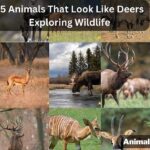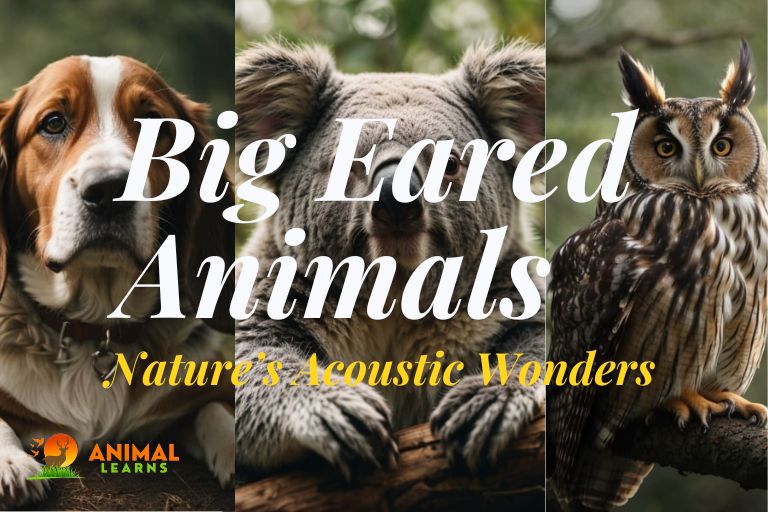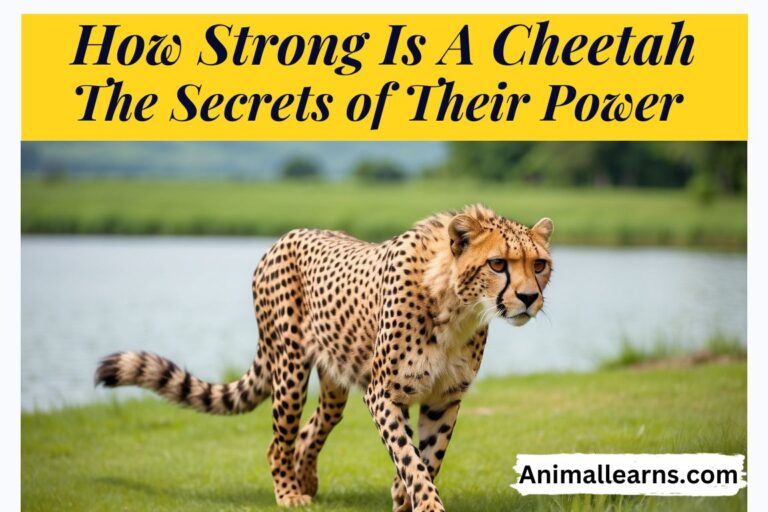American Bison: Facts, Types (with pictures) – Animallearns

The biggest land mammal in North America, American bison are distinguished by a narrower hindquarter region and a hump over the front shoulders. A single set of short, hollow horns with sharp points that curl upward and outward from the sides of the enormous head is shared by both male and female bison.
Long, dark hair covers the head, neck, forelegs, and front portion of the body in a dense layer. The mature bull acquires a foot-long black beard to his thick coat. The hair on the back of the body is substantially shorter.
Since the animal stands facing the wind during blizzards, its shaggy head serves as the most strongly insulated section of its body. In the spring, animals shed their heavy coats by rolling to release the hair, which then falls off in gobs.
| Characteristic | Information |
| Scientific Name | Bison bison |
| Common Names | American Bison, Buffalo |
| Subspecies | Plains Bison and Wood Bison |
| Average Height | Up to 6 feet (1.8 meters) at the shoulder |
| Average Weight (Male) | 1000-2000 pounds (450-900 kg) |
| Average Weight (Female) | 800-1000 pounds (360-450 kg) |
| Physical Features | Deeply rooted in Native American culture, a national mammal of the United States (2016) |
| Lifespan | 15-25 years |
| Diet | Herbivorous, primarily grasses and vegetation |
| Habitat | Grasslands, prairies, woodlands, and open plains |
| Range | Historically North America, now mainly found in conservation herds |
| Behavior | Social herds, migratory, vocal communicators |
| Speed | Up to 35 mph (56 km/h) |
| Role in Ecosystem | Environmental engineers, grazers, maintain grasslands |
| Conservation Status | Near Threatened (Plains Bison), Vulnerable (Wood Bison) |
| Cultural Significance | Environmental engineers, and grazers, maintain grasslands |
Bison Behavior and Traits
Contents
The American Bison: A Journey into Their World
They also known as the buffalo, are the living legends of the American wilderness. They have a fascinating and complex life, marked by various behaviors, characteristics, and cycles that reflect the natural rhythms of their environment.
In this section, we will explore the amazing world of the bison, and learn more about their features, habits, and challenges.
What Do They Eat and How Do They Affect Their Ecosystem?
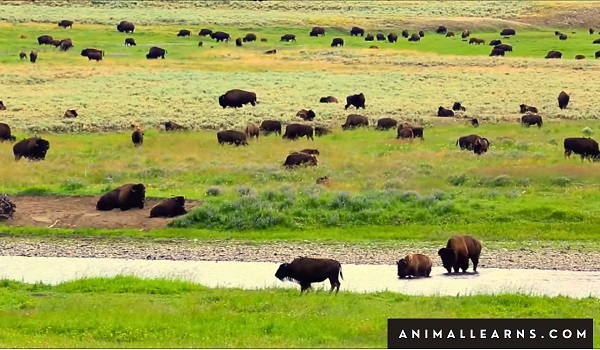
They are herbivores, meaning they eat plants, mainly grasses and other vegetation. They have a huge appetite and a strong digestive system, which allows them to consume large amounts of plant matter every day.
They are also formidable grazers, meaning they have a significant impact on the ecosystems they inhabit. By grazing, they help maintain the diversity and health of the plant communities they feed on.
How Big Are They and What Do They Look Like?
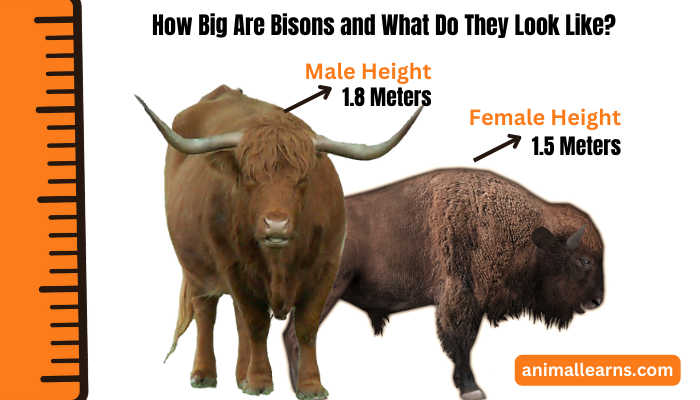
| Attribute | Bison (Males) | Bison (Females) |
|---|---|---|
| Height (at the shoulder) | Up to 6 feet (1.8 m) | Around 5 feet (1.5 m) |
| Weight | Up to 1 ton (900 kg) | Up to 900 pounds (400 kg) |
The bison are impressive in size and appearance. They are the tallest and heaviest land animals in North America, with males standing up to six feet (1.8 meters) at the shoulder and weighing up to a ton (900 kilograms), and females standing around five feet (1.5 meters) at the shoulder and weighing up to 900 pounds (400 kilograms).
One of their most distinctive features is the hump on their shoulders, which is made of powerful muscles that help them dig through snow and vegetation in winter.
Their fur is thick and brown, and it grows longer around their head and faces, creating a beard and a mane.
Their head is big and strong, with a thick skull that protects them from predators and rivals. Both males and females have short, curved, black horns that can grow up to two feet (0.6 meters) long.
How Do They Reproduce and Grow?
They have a remarkable life cycle that shows their resilience and adaptability. Calves are born in spring, usually between April and June, after a gestation period of about nine months.
These calves are called “red dogs” because of their reddish-brown coats. They grow quickly and stay close to their mothers for protection.
As they grow older, bison form social groups based on hierarchy, with dominant males leading herds of females and young ones.
They have a nomadic lifestyle that involves moving from place to place in search of food and water. They have a natural tendency to roam long distances.
What Are Their Traits and Behaviors?
They have a range of interesting traits and behaviors that reveal their personality and intelligence. They can communicate with each other through sounds and gestures that convey different messages within the herd.
Bison are generally peaceful animals like kangaroos and rabbits, but they can become aggressive during mating season or when defending their territory. Males may compete with each other by clashing their heads in a display of strength.
Throughout their lives, Bison show adaptability and resilience, which have helped them survive through many challenges and changes in their environment.
American Bison Facts
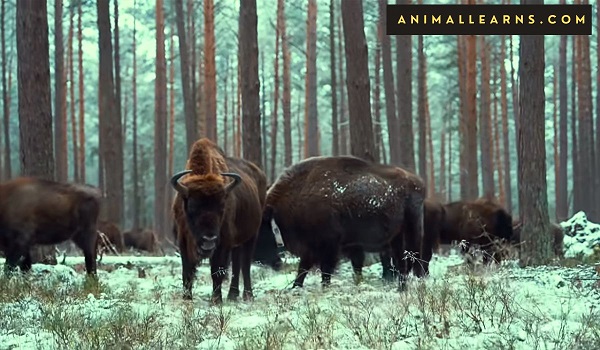
The American bison, or buffalo as they are often called, are the wonders of the North American wilderness. They have a fascinating and rich history and a variety of amazing traits.
These huge herbivores, famous for their resilience, have lived in North America for thousands of years.
In this article, we will explore some fascinating facts about bison that reveal their uniqueness and captivating behaviors.
Ice Age Survivors
Bison are among the few animals that survived the Ice Age when mammoths and saber-toothed cats roamed the Earth. They have a long and rich history that dates back millions of years.
Their ability to adapt to different environments and challenges is remarkable.
Mighty Migrators
Bison are famous for their long and epic migrations, traveling hundreds of miles in search of fresh grass and water. They follow the seasons and the availability of food, showing their flexibility and nomadic nature.
Social Animals
Bison live in large and friendly herds, where they form strong bonds with each other. They cooperate and communicate as a group, making decisions about where to go and what to do. The herds are usually led by dominant males, but everyone has a say.
Vocal Communicators
Bison may not seem very vocal, but they actually have a range of sounds that they use to express themselves. They grunt, snort, and bellow, especially during the mating season. These sounds convey their mood and intentions, helping them avoid conflicts and attract mates.
Dust Lovers
Bison love to roll in the dust, creating clouds of dirt around them. This is not just for fun, but also for hygiene and health. Rolling in the dust helps them clean their fur and get rid of parasites. It also makes them look more impressive and intimidating.
Shaggy Coats
The thick, shaggy fur of bison serves many purposes. It keeps them warm in the cold winters, protects them from insects and predators, and blends in with their grassy habitats. Their fur is so dense that snow can accumulate on their backs without melting.
Speedy Runners
Bison may look slow and clumsy, but they are actually very fast and agile. They can run at speeds of up to 35 miles per hour (56 kilometers per hour), which is faster than most horses. This speed helps them escape from danger and chase away intruders.
Ancient Symbolism
Bison have a deep cultural significance for Native American tribes, who have lived alongside them for centuries. Bison symbolize strength, endurance, and the interconnectedness of all living beings. They are featured in many Native American art forms, stories, and rituals.
Bison’s Comeback
Bison have a remarkable story of resilience and recovery. They were once nearly extinct due to overhunting and habitat loss, with only a few hundred left in the wild. Thanks to conservation efforts, their numbers have increased significantly, reaching over 500,000 today.
National Symbol
Bison were declared the national mammal of the United States in 2016, joining the Bald Eagle as an official symbol of the country. This recognition honors their importance to American history and culture, as well as their contribution to wildlife conservation.
Types of American Bison
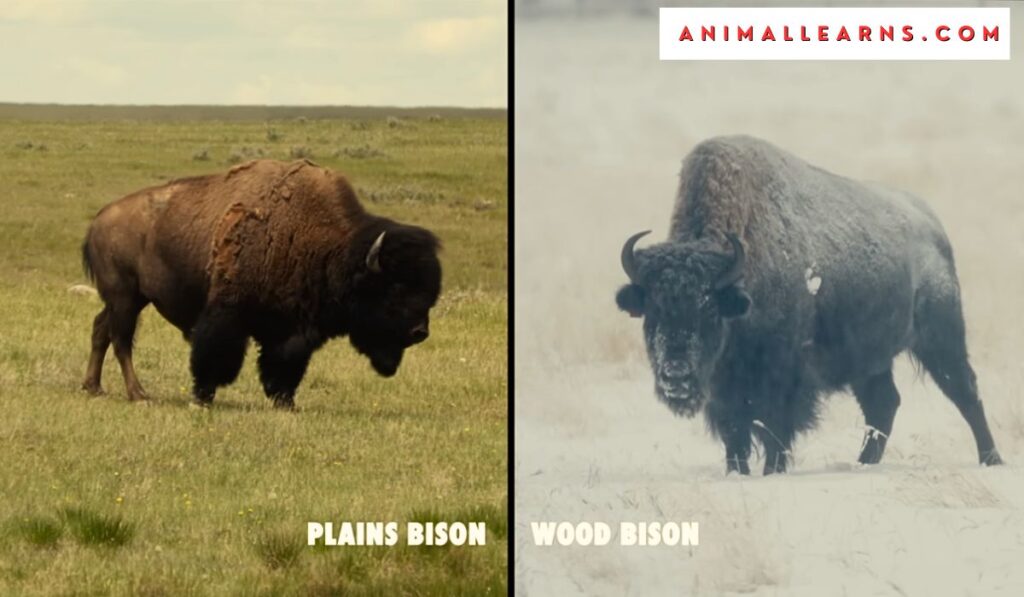
This is a magnificent animal that has a long and rich history in North America. But did you know that there are actually two different types of bison that belong to this species? In this article, we will introduce you to the two subspecies of bison and explain how they differ from each other. Let’s get to know these amazing creatures better:
Plain Bison
This is the most common and widespread type of bison, which used to roam the central and western parts of North America.
They have a smaller body size and a lighter fur color than their northern cousins. They prefer open grasslands and prairies, where they graze on various plants and grasses.
Wood Bison
This is the larger and rarer type of bison, which historically lived in the northern boreal forests and plains of Canada and Alaska.
They have a bigger body size and a darker fur color than their southern cousins. They favor wooded areas and wetlands, where they feed on sedges and other aquatic plants.
These two types of bison have different physical traits, behaviors, and habitat preferences, but they are both part of the bison species. They are also both endangered due to overhunting and habitat loss, but conservation efforts are helping them recover.
These magnificent animals are keystone species, contributing to the health of grasslands and supporting various wildlife. While they can be aggressive and should be respected, they are a symbol of the American wilderness and its resilience.
The American bison have much more to offer than what we have covered so far. As we continue our journey into their world, we will discover more aspects of their lives, such as their role in ecosystems, the threats they face in the modern world, and the efforts to conserve these magnificent creatures.
Conclusion
The American Bison, or the buffalo, is not only a symbol of the American West, but also a symbol of the strength, endurance, and resilience that nature possesses. The Bison has survived many challenges and thrived in the wild.
The American Bison, or the buffalo, is an iconic species that needs our appreciation and support. The comeback of the Bison shows how we can make a positive difference when we work together to protect our natural heritage.
FAQs
Why are bison famous?
The Bison is not just an animal, but a symbol of many things. It is the largest land animal in North America, a key part of Native American culture and history, a survivor of near-extinction, and the national mammal of the United States.
How many bison are left?
The Bison is a rare and precious animal. It lives in conservation herds and manages populations that protect it from harm. My latest knowledge update, there were about 31,000 Bison in North America.
How aggressive are bisons?
The Bison is not an animal you want to mess with. It can show aggression, especially when it is mating or when it feels its young are in danger.
Who eats the bison?
The Bison is a plant-eater, feeding on grasses and plants. It has natural enemies like wolves and grizzly bears, but it is not easy to catch.
Can American bison jump?
The Bison is a vast and heavy animal, but it can still jump. However, it cannot jump very high compared to its size and weight.



